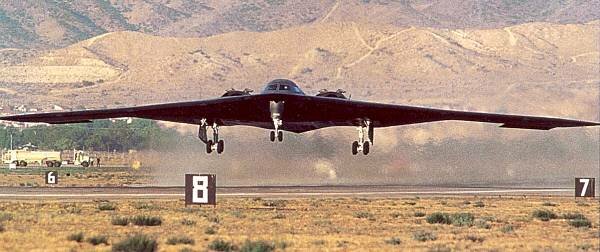Development
The first B-2 was publicly displayed on November 22nd 1988, when AV-1 (82-1066) was rolled out of its hangar at Air Force Plant 42, Palmdale, California. At this point AV-1 was a long way from being ready to fly; many internal parts had not yet been installed.
AV-1 carried out its first taxi tests on July 10th 1989, during which it reached a maximum speed of 103 mph. Its first flight was made on July 17th 1989, when it was flown from Palmdale to Edwards AFB, California, by Northrop B-2 division chief test pilot Bruce J. Hinds and copilot Col. Richard S. Couch, the commander of the B-2 Combined Test Force at Edwards. The aircraft departed Palmdale at 06:38 local time; the flight lasted 2 hours and 12 minutes.

The B-2 Combined Test Force was responsible for flight testing the Engineering, Manufacturing and Development (EMD) aircraft. The first B-1 was assigned to the 6520th Test Squadron, 6510th Test Wing.
AV-1 didn't make its second flight until August 16th 1989. It flew one hour of the scheduled 3 hours+ flight, before a minor problem with its auxiliary power system forced a return to Edwards. On its sixth flight on November 8th 1989, AV-1 carried out air refuelling for the first time.
AV-1 flew with an all-USAF crew (Lt Col Tom Lebeau and Lt Col John Small) on its tenth flight, on May 3rd 1990. This flight lasted 7 hours 23 minutes.
Aerodynamic performance and airworthiness formed Block 1 of the test program, and was completed in 13 flights totalling 67 hours up to June 30th 1990.
The second prototype, AV-2 (82-1067) flew on October 19th 1990 from Palmdale to Edwards, and AV-3 (82-1068) did the same on June 18th 1991. AV-2 took over flight envelope expansion from AV-1. It also carried out flutter, load, landing gear and weapons bay door tests. AV-3 was the first aircraft fitted with the ALQ-181 radar (in 1993), and carried out much of the avionics testing.
Block 2, the critical Low Observables (LO) testing began on October 23rd 1990. This was much earlier than Northrop and the Air Force had planned, but Congress required it before production funding would be released.
During the eleventh such flight on July 26th 1991, AV-1 showed a larger reflection than expected from one particular aspect and one radar requency (believed to be VHF). An early conclusion was that the problem could be solved by changing coatings and edge materials. There was no need to change the basic shape of the aircraft, which meant that the solution could be retro-fitted.
It was clear from the tests that the B-2 was even more stealthy than the F-117; by then the latter had been proved in combat over Iraq, where it had penetrated the air defences around Baghdad without being detected.
On March 20th 1992 AV-1 was placed in long-term temporary storage at Palmdale. It had flown 81 sorties for 352.6 hours.
AV-4 (82-1069) made its first flight on April 17th 1992. It carried out most of the avionics and weapons testing.
The B-2 made its first night flight on June 4th 1992.
On September 3rd 1992 AV-4 (82-1069) released an inert 2000lb Mk84 bomb from an altitude of 6500m at Edwards AFB. Subsequently, dummy B61 and B83 nuclear weapons, and Mk82 500lb bombs were dropped.
On October 2nd 1992 the Edwards trials units became the 420th TS and the 412th TW.
AV-5 (82-1070) first flew on October 5th 1992. It was initially used for LO comparisons with AV-1, before being delivered to the McKinley Climatic Laboratory at Eglin AFB, Florida, for six months of bad weather trials.
AV-6 (82-1071) first flew on February 2nd 1993. This spent six months on the ground for Technical Order validation. This involved the aircraft being completely dismantled and reassembled so that a maintenance manual could be written.
Also in February 1993 AV-3 began testing the Northrop ZSR-63 defensive avionics suite, followed in November by the first use of the terrain-following mode on the Hughes AN/ALQ-181 low-probability-of-intercept (LPI) radar
The first production aircraft, AV-7 (88-0328), was completed in August 1993 but leased back to Northrop for electromagnetic compatibility and emissions security trials.
By December 1993, AV-2 had flown 98 sorties totalling 496.4 flight hours.
By the time that the first aircraft was delivered to the Air Force on December 17th 1993, the B-2 had competed fatigue testing to 20000 hours; undertaken all navigation and autopilot trials; passed static load tests; completed flutter clearance; performed a simulated 9.2 hour bombing mission; cleared the flight-refuelling envelope with KC-10 and KC-135 tanker; and flown at a take-off weight 80% of maximum.
On December 31st 1993, AV-5 successfully completed a six-month test program at the Climatic Testing Laboratory at Eglin AFB.
By March 1st 1994 the six EMD aircraft had logged more than 1600 hours in more than 340 flights. By the end of 1994 they had accumulated more than 2300 hours in over 490 flights.
In February 1994 the aircraft was officially named Spirit, although at Whiteman is is known simply as "the jet".
The basic B-2 test program was completed on July 1st 1997. The effort had taken 8 years and 5000 hours of testing.
| <<< Weapons | Top | Production >>> |
